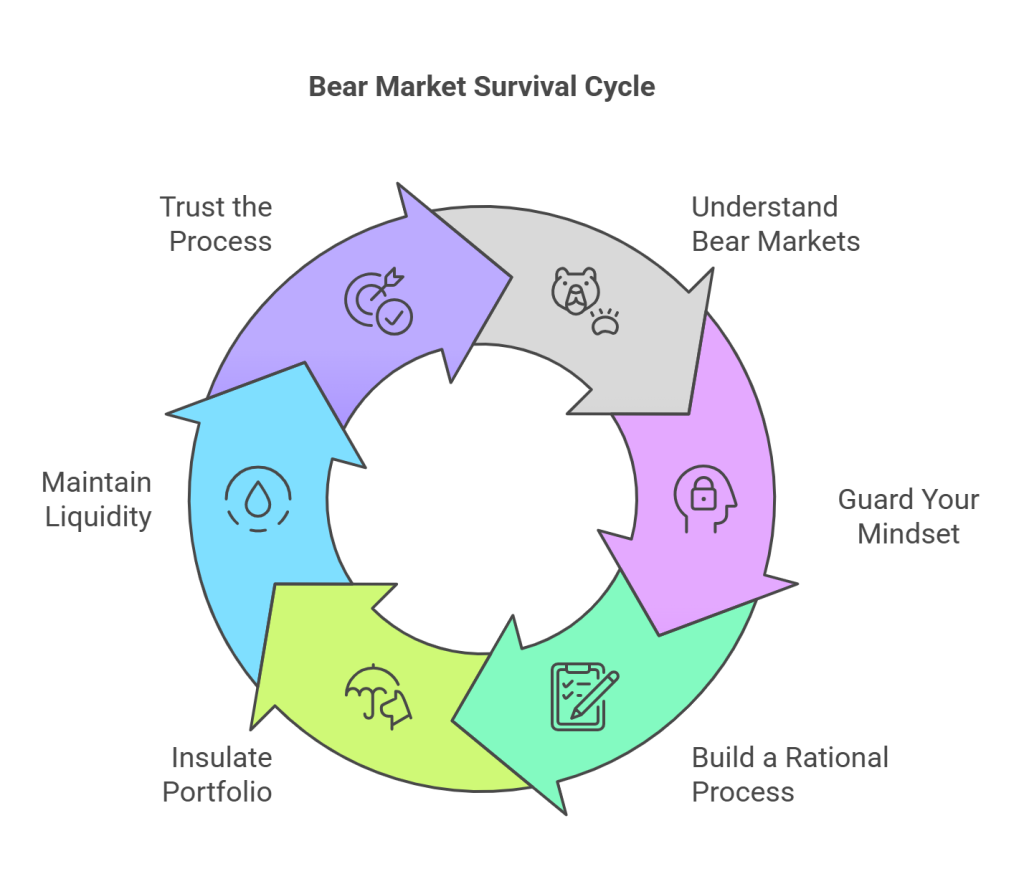
The Market Is Crashing—Now What?
We are in the bear market in S&P 500 and Russell 2000 indices.
Bear markets don’t whisper. They scream. Prices fall fast, headlines get apocalyptic, and suddenly every investor is questioning their entire approach. You might feel the urge to do something—anything—to stop the bleeding. But acting out of fear is how wealth gets destroyed. In this guide, you’ll learn how to stay grounded when everyone else is losing their head—and why keeping your cool gives you a lasting edge.

What Exactly Is a Bear Market—and Why It Feels So Personal
Before we get into survival strategies, let’s define the storm. A bear market is typically defined as a 20% or greater drop in a broad index. But definitions aren’t what shake portfolios—feelings do. The fear of loss triggers real emotional pain, often more intense than the joy of gains. For value investors, this psychological stress can be amplified when holding unpopular or illiquid positions.
Once you understand the emotional and structural weight of a bear market, the next step is mastering your mindset.
Your Mind Is the First Thing to Break—Guard It Like Your Capital
Panic is contagious. CNBC, Twitter, and even your group chats will push narratives that seem urgent and dire. But bear markets are not emergencies. They’re opportunities in disguise. Recognize the fight-or-flight response for what it is: a relic from evolution, not a financial plan. Train yourself to pause. No decision should be made in haste. And remember: price action is not the same as business value.
Once you’re in the right headspace, you need a system that removes emotion from the equation.
Build a Process That Makes Rationality Your Default Setting
The investors who thrive in bear markets don’t rely on willpower—they rely on process. Use pre-calculated fair values for your stocks so you know what’s cheap. Because I write research reports, I have the habit of writing down the fair values. You should do this too, perhaps in an investment journal.
Set buy and sell limit orders in advance. Let math, not fear, do the work. Make these orders execute automatically when it hits your limit. Rebalance based on updated expected returns, not on price movements alone. If the business has declined, perhaps your updated expected returns also changed.
Limit news consumption. Read annual reports, not headlines. You want to be in full control of your decisions, not swayed by 100 different opinions.
Your process protects you from yourself. But what about the portfolio itself—how should it be positioned?
Insulate Your Portfolio from Permanent Capital Loss
Your job during a bear market isn’t to predict the bottom. It’s to protect your downside and position for the recovery. Start by focusing on businesses that generate consistent free cash flow and have little to no debt. These are the companies most likely to weather the storm without needing to refinance at punishing rates or dilute equity to stay afloat.
Next, take a hard look at your holdings and ask whether each company has a durable competitive advantage that can carry it through a downturn. If a company’s edge is intact, the market will eventually reward it. But if that edge is eroding, it may be time to cut your losses.
Don’t average down just because the price is lower. Only add to a position if your original thesis is still valid and the risk-adjusted return at the new price is even more attractive. Blind averaging down often leads to overexposure in broken stories.
Finally, consider allocating more capital to strategies that don’t correlate with the broader market. These might include cash-flow-focused or income-producing assets, like the types we hold in our Founder’s Club portfolios.
Protection is critical, but so is staying in the game long enough to benefit from the upside. If your capital survives, your future profits will thrive.
Remember: Survival Is the Strategy
Bear markets are not the time to optimize for outperformance. They’re the time to avoid ruin. If you can keep your capital intact—and your confidence high—you’re already outperforming most investors. Stay liquid enough to take advantage of irrational discounts. Revisit your long-term plan and remind yourself why it works. If you find yourself wanting to do something drastic—don’t. Often, doing less is the better move.
It’s easy to forget this in the moment, but every bear market ends. And how you behave during one defines your long-term returns.
What Comes After the Panic? Ascent.
History is clear: the bigger the crash, the greater the recovery. Value investors don’t just survive bear markets—they set themselves up for decades of wealth. When quality assets are selling for pennies, your future compounders are born.
By staying rational, you lock in higher yields, accumulate more shares, and build confidence in your strategy. And that’s how you turn a crisis into your advantage.
This Is the Time You Were Built For
You didn’t become a value investor to follow the herd. You chose this path because it works—especially when others panic. Bear markets are tests of temperament more than skill. Stay disciplined. Stick to your process. And trust that while the crowd screams, you are quietly compounding future wealth.
Learn more about the business models that do well in bear market.

Shailesh Kumar, MBA is the founder of Astute Investor’s Calculus, where he shares high-conviction small-cap value ideas, stock reports, and investing strategies.
His work has been featured in the New York Times and profiled on Wikipedia. He previously ran Value Stock Guide, one of the earliest value investing platforms online.
Subscribe to the Inner Circle to access premium stock reports and strategy insights.
Featured in:








